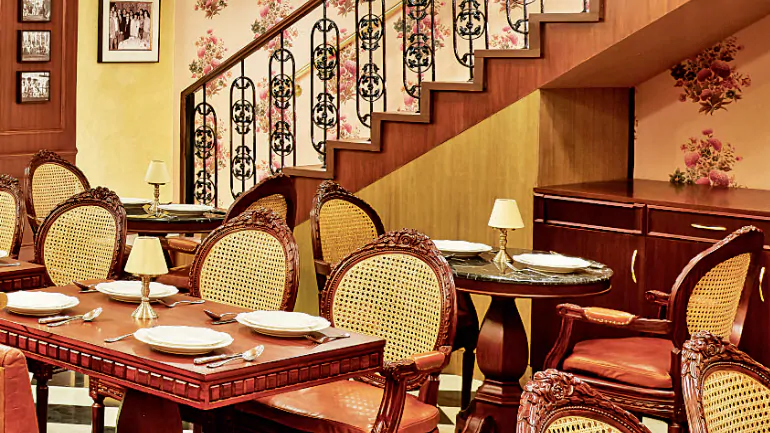Over the past few decades, the frenzied pace at which Delhi has transformed, finds reflection in its food scene. Many millennials have just two demands of an eating joint: that the restaurant is stylish and the liquor is served quickly.
In South Delhi, hipper restaurants in Hauz Khas Village still find takers even as a large number of restaurants have disappeared after a stint of less than two years. In the demanding club and bar-hopping scene of 2019, it is somewhat astonishing that several decades-old eateries have not just survived, they are flourishing.
A number of these old haunts from the pre-Partition era are located in Connaught Place. Others, such as York, Ginza and La Boheme, says renowned food critic and academic Pushpesh Pant, survive on the marquee but their souls have departed.
The footfalls are heading towards more permissive resto-bars and franchised fast food joints, adds Pant. Some of the restaurants haven’t just preserved their businesses and their identities, they are perceived as some of the biggest food brands in Delhi.
So, how does an eatery attain iconic status?
KWALITY, NOSTALIGIA’S NEW FACE
Started in 1940 by Pishori Lal Lamba as an ice cream store which catered to American GIs, Kwality has undergone a dramatic makeover. As it grew, its clientele expanded to rich Delhiites and Anglo-Indians. But it stood out from other restaurants even in the beginning, says Pant, Kwality was far less intimidating than the other upscale restaurants. PL Lamba, who came to Delhi from Lahore in Pakistan, never forgot his humble beginnings as a refugee and his eatery bravely bridged the divide between social classes and the conflicting claims of Continental’ and desi cuisines. It served Fish Portuguesa, Hamburger Steaks, Fish n Chips along with Chhole Bhature.
Divij Lamba, grandson of Pl Lamba, explains, These dishes were a mix of traditional Punjabi food and British club food to appeal to both the Indian and Anglo-Indian clientele. Also back in the day, there were no complex ovens. It was a very rustic process of roasting meat. It had been a mix of Indian and Anglo-Indian food, which was a reality at that time.
Housed in Connaught Place’s Regal Building, it is now a multi-storey, dimly lit restaurant, with black and white photographs lining the walls, and silverware. But Kwality’s chole bhature is still a favourite, as is the Chicken A la Kiev.
It took a new avatar last year, with a complete revamp. Lamba adds, We wanted people to feel they had entered a different era when they walked in. We also wanted it to retain its historical charm, and appeal to a new range of customers.
He goes on to say, Our appeal cuts across generations. It’s a piece of the past that makes people yearn for the modern age, and connects people to an older era. Nostalgia has come back into fashion.
AC Chawla, 63, a retired statistician, agrees, It was a place where you went with your family. Adds Shikha Bansal, a 59-year-old teacher, I used to go there every Saturday for their sizzler dishes. They didn’t have as many choices as they do now, but even then, what they had was good.
Like other old favourites, Kwality has always been popular with politicians and Bollywood stars. Lamba says, In the middle of CP, it’s a place people can come to when they want to spend money on an experience of comfort and culture.
UNITED COFFEE HOUSE: A HUB TO EXCHANGE IDEAS
While Kwality has drastically changed its avatar, United Coffee House, also a Connaught Place landmark, has kept up the appearance of its original, even as it experimented with a number of cuisines.
Says Akash Kalra, who has been running UCH for the past 28 years, Built in 1942, we are Delhi’s first café. In the pre-Partition days, there were no dining options as such. Neither did the concept of a coffee house exist. When we began, we conceived the idea of a coffee place where people could gather and share ideas.
He goes on to explain the origins of its name. During those times the tide was for writers, freedom fighters, journalists, poets and intellectuals, to unite and share their thoughts and have a good time. That was how we had started, and that was why we called it United Coffee House.
Gradually, spurred by the demands of its patrons, UCH became a multi-cuisine restaurant. As the first multi-cuisine restaurant in India in the 1940s and 1950s, it was unafraid to take risks, to meet the demands of changing tastes. In this way, it not only sustained its client base, it has now expanded to the millennials.
Declares Kalra, The hard work of three generations has gone into achieving this. We try to reinvent whatever has always been popular. To create a mélange, or a bridge between the old and new, we have always stood by the old classics, and always created the new. Anything which is in vogue will always be in my menu.
UCH can boast of the who’s who as celebrity clients, over the years. From Jawaharlal Nehru, to Indira Gandhi, and all the Raja Sahebs, including the Maharaja of Patiala, they all came here. MF Husain was a regular, and the famed Urdu poet Kaifi Azmi also used to come when he was in town.It has always been a safe place where eminent personalities can relax and engage with each other. More than the food, it has nourished a sense of community. Today, it is an aspirational brand for young people.
But the old-timers continue to come. Kalra mentions a group who routinely eat there after their activities at the Delhi Golf Club. They carry on that legacy. That is part of why we are still going strong.
As eminent food historian Osama Jalali puts it, Even when they revamped, the décor remained the same. They replicated the chandeliers which originally came from Belgium, with new replicas, which also came from Belgium.
KARIM’S, 100 NOT OUT
Karim’s, near the Jama Masjid, began as a small outlet that served meat dishes to 14-15 customers on benches in 1913. As Anuj Sahani, 64, an artist, says A lot of people went here in my time. We didn’t really go there for the atmosphere, as it was just benches and tables; we went there for the quality of the food, and extremely reasonable prices.
Now, it is a large restaurant, with air-conditioning, that can seat up to 200. Zaeemuddin Ahmed, director of Karim’s Pvt Ltd, and the great grandson of Haji Karimuddin who founded the eatery, says, We have flourished for 106 years, as we have been taught that when it comes to food and spices, never compromise on quality. Ahmed goes on to say, We have been maintaining the same taste since 1913.
Even after so many restaurants have opened, people still prefer the non-vegetarian food of Karim’s.
Indeed, affirms Jalali, the menu has remained the same for over a century. It is essentially the same food that was eaten in Mughal times. We even use the same spices, such as cardamom and pepper, the same way, as well as dahi and garam masala. You don’t find these elements in fast food kitchens, says Ahmed.
To keep in sync with the sensibilities of their modern clients, says Ahmed, Karim’s underwent a series of renovations. Today, when people want to eat, they also expect an ambience.
On the roster of celebrities who’ve savoured Karim’s succulent delicacies over the years are actors Dilip Kumar, Sunil Dutt, Raj Kapoor and Shabana Azmi; singer Lata Mangeshkar, and cricketers Gautam Gambhir and Ajay Jadeja.
Today it has become a city milestone. Tourists come here see the Lal Qila, India Gate, and Karim’s. Our mutton seekh kebab, badam pasanda, brain curry are the hot selling items. One can get chicken anywhere, but the best mutton can only be found here, claims Ahmed.
As Akanksha Sachdeva, 23, who works in a travel website, says, I love the Chicken Jahangiri, the mutton korma, and the phirni. There’s nowhere else quite like it.
MOTI MAHAL, FLEXIBLE DOES IT
Another old brand located in Daryaganj that has withstood the ravages of time is Moti Mahal. Set-up in Delhi by Kundan Lal Gujral in 1947, it can be credited with creating the butter chicken, and propagating the spread of tandoori cuisine in Delhi.
Gujral’s grandson, Monish Gujral, who had joined the family business in 1983, explains why they are going strong after a century. Every brand needs reinvention over the years. My grandfather had started it, but expectations, along with people change over the years.
He goes on to say, With the arrival of food chains such as McDonald’s into India, people had started to experiment. To keep pace with the changing palates of our patrons, we had to stay relevant. Food is like the fashion industry, so we need to keep up with the flavour of the month, he explains.

Gujral is emphatic when he says the restaurant doesn’t do fusion, but he does admit to being flexible, and giving the menu a modern twist whenever necessary.
Apart from the food, another favourite of Moti Mahal is the Qawali tradtion in their courtyard. Gujral says, My grandfather was a connoisseur of this music, and he promoted it as hallmark of Indian culture. Now it happens once a week.
Says Srijit Anant, 62, an architect, Some of my fondest memories are from this restaurant. We used to go in these large contingents with family friends (most of whom, oddly enough, were vegetarian), and eat there and listen to qawwali in the evening. It continues to be a favourite. As Anjum Desai, 24, a student of economics, puts it, The really authentic butter chicken in Delhi is here, and their Mughlai is always fantastic. Among its celebrity patrons, Maulana Azad, is said to have remarked, Coming to Delhi without eating at Moti Mahal, is like going to Agra without seeing the Taj. The Kennedys and, much more recently, Gordon Ramsey were some of its noted patrons.
OLD VS NEW
One reason these eateries have attained iconic status is the nostalgia attached to it, and the stories behind them. Particularly, if there are success stories behind them, as they have started out as small outlets, to becoming the flourishing establishments they are now. As Jalali puts it, In today’s time, few of the new restaurants survive longer than a year. People today may be moving towards progressive cuisines, but at the end of the day, they will still gravitate to what is comfortable and familiar and the experience which only old-school cuisines can offer. They also serve consistently good food.
He adds, These old-school restaurants also have patience. Newer restaurants run by MBA graduates hire executive chefs don’t take the time to really give a new dish a chance, to give the patrons time to enjoy tasting them. These restaurants knew how to give new recipes and dishes time, and eventually these dishes were perfected, and went on to become classics.
He goes on to comment that several of these old restaurants are purists. They maintain their traditions by sticking to old cuisines and menus. Old restaurants thrive because they didn’t see it as business, but as family-run ventures, and had perpetuated the tradition. These restaurants also promote regional Indian cuisine, instead of international food, adds Jalali.
There are countless memories and emotions tied to these haunts. These restaurants remain old and new favourites, and the traditions have lingered.
tiktok takipçi satın al




